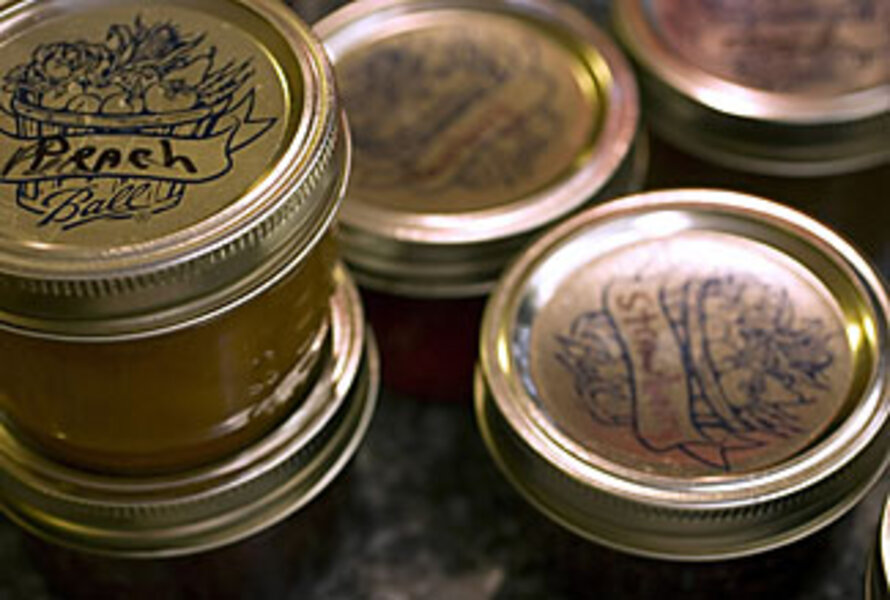Fresh berries make the best jam
Loading...
I peer to the back of the freezer shelf, sorting through mixed vegetables, ice packs, and containers of frozen chili in search of just one more jar. But tonight's biscuits will be bare. We're out of jam.
My family's farm roots surface when it comes to jam. Jam wasn't something we bought. It was something Mom made – or retrieved from Grandma's house when our family's supply ran low. When you were sent to the basement freezer or pantry for jam, you had your choice: black raspberry, strawberry, blackberry, red raspberry, ground cherry, or the highly coveted wild thimbleberry.
We knew better than to throw out a glass jar. Small jars were saved for jam, larger ones for chili sauce, pickles, or applesauce. One cousin carted boxes of empty glass jars hundreds of miles every time she drove home. Better to deliver them to a jam-making aunt or grandmother than suffer the guilt of pitching a perfectly good jar.
My biggest challenge in making jam is finding local, home-grown berries. Those beautiful megastrawberries in the produce section of the grocery store just don't have the intense flavor that makes unforgettable jam. Home-grown strawberries tend to be far smaller, seedier, and not nearly as stunning on a fruit tray. But their taste is incredible, and a stockpot of boiling jam creates a strawberry aroma that can't be duplicated. So each spring, I search for "pick your own" farms on the Internet, check the agriculture section of the classified ads, mark the dates of farmers' markets on the calendar, and hope that the right mixture of rainfall and temperature will bring a bumper crop of berries.
Blueberry farms are the easiest to find in my area. And blueberries are simple to pick, too, with bushes at eye level loaded with clusters of ripe berries in a good year. Strawberries, on the other hand, require stooping or kneeling. Poison ivy can lurk between the rows of plants, and it takes a lot of tiny berries to fill a box.
When I took my neighbors picking for the first time, one of the strawberry-loving little girls was hugely disappointed. She must have imagined strawberry bushes higher than her head, covered with giant berries ready to pop into her mouth or bucket. Instead, crawling in the dusty rows and searching under strawberry runners for any remaining thumb-size berries, we barely got enough for a batch of jam each. Next time, I'll take them earlier in the picking season.
I haven't yet tackled making jam with hot water baths, pectin, and melted paraffin seals. Freezer strawberry jam is simply much less intimidating. It doesn't require any more specialized equipment than a potato masher and a jar funnel. You just need fresh strawberries – picked that morning, if possible – sugar, and clean jars.
Here's our family recipe: Wash and hull the strawberries. (Never wash a berry until right before you're ready to use it.) Crush the berries with a potato masher until you have three cups of berry pulp. Add 2 cups of sugar (or less if the berries are especially sweet). Place this in a large saucepan and let the mixture bubble to a full rolling boil. Remove it from the heat and stir in an additional cup of sugar until it's dissolved.
Let the mixture stand in a bowl overnight on your counter. You can double the recipe if you have enough berries. The next day, ladle the jam into clean jars (wash the jars and lids in the dishwasher first). Store your jam in the freezer for up to two years. When you keep a jar in the refrigerator, the jam will be a bit runny. But the flavor makes up for it, and an open jar won't last long.
I'm too far from Michigan's Upper Peninsula to find wild thimbleberry bushes, but I'm toying with buying a jar or two of the jam online. My childhood favorites, black raspberries, seem to have almost disappeared. But in my region, strawberries usually ripen around Memorial Day. Last year, a late freeze devastated the entire crop. I heard from a grower via e-mail today that so far, the crop looks good. I'm thinking positive. It's time to clean out my freezer.





